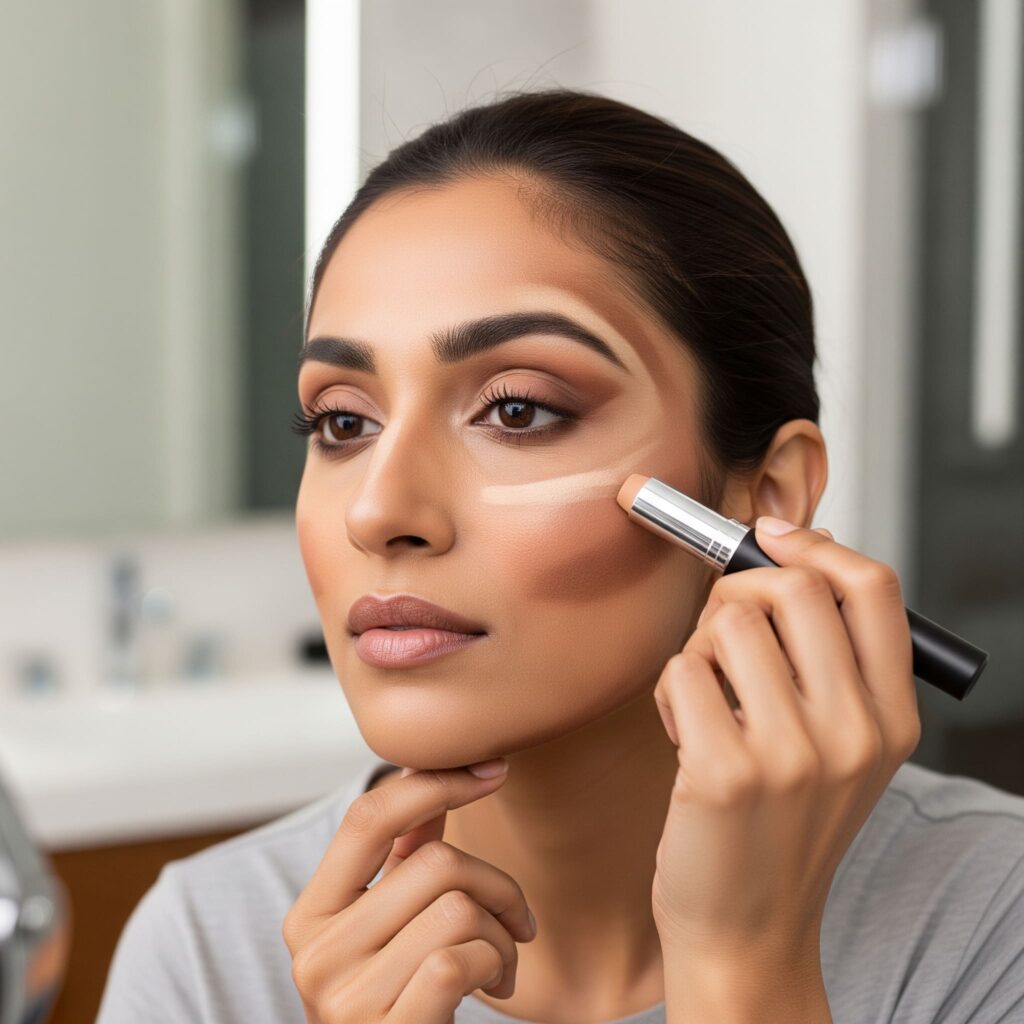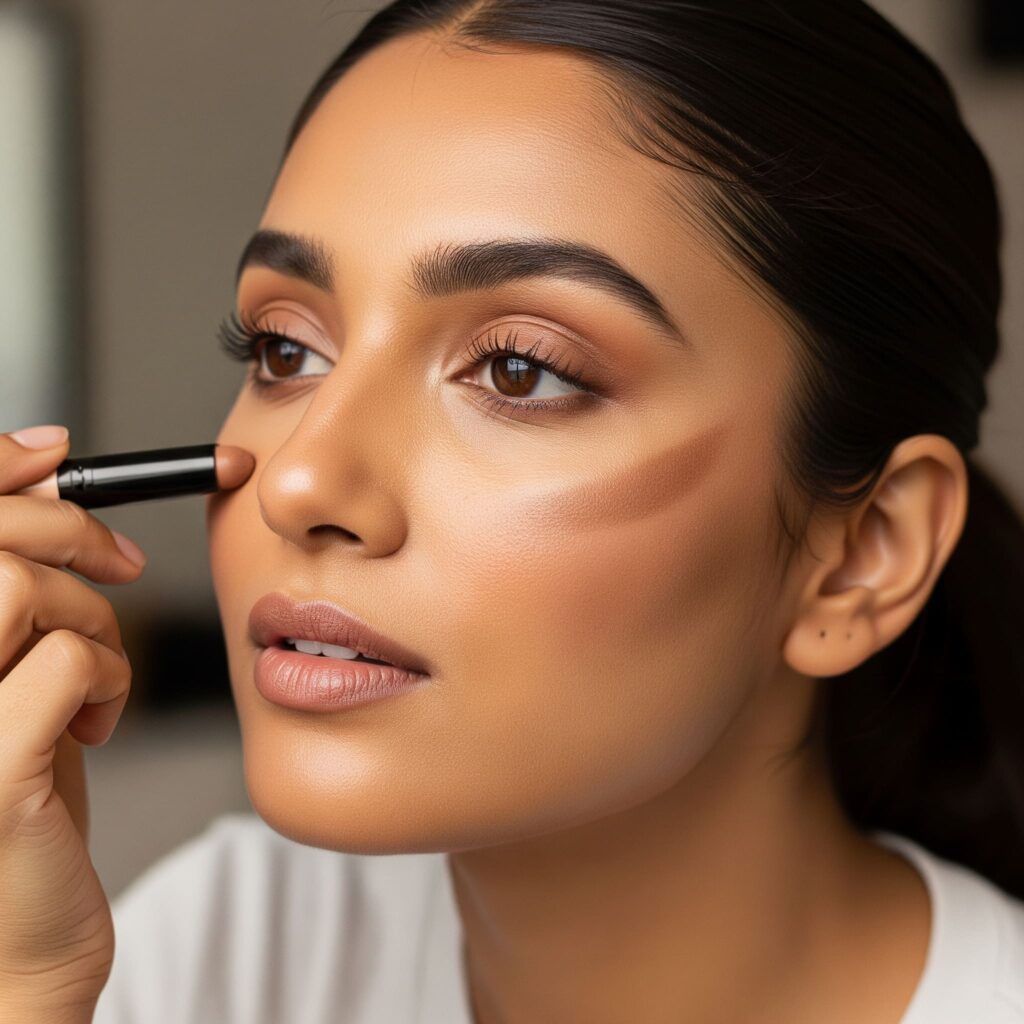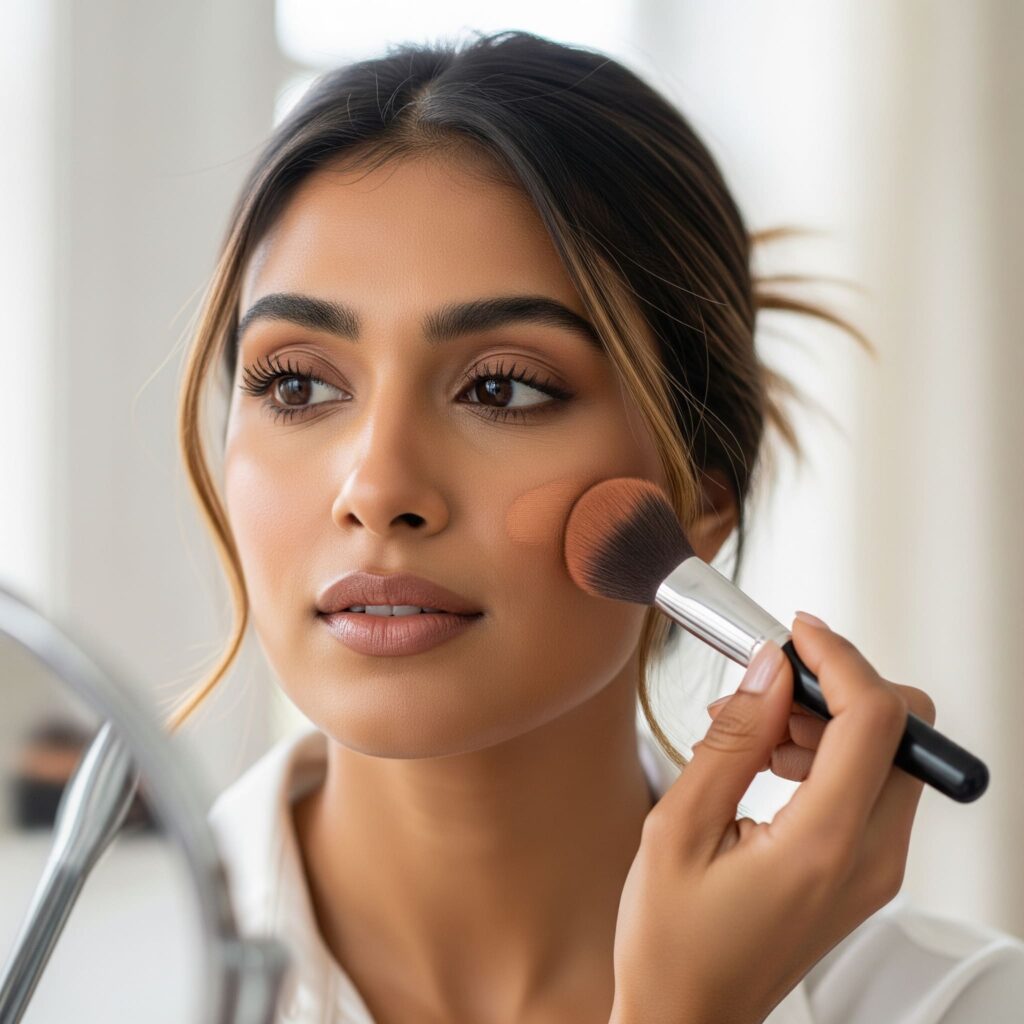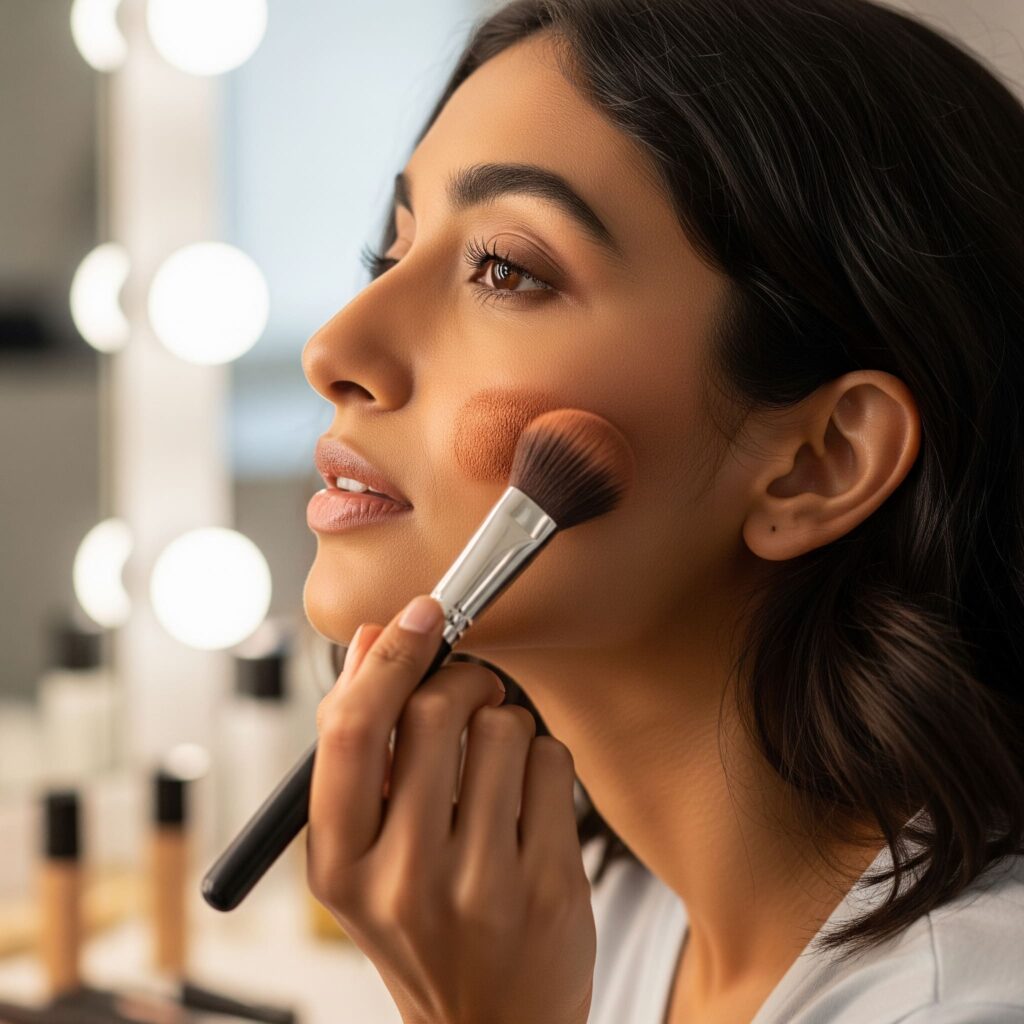Choosing the right makeup products to enhance your natural beauty can sometimes be confusing, especially when it comes to contour and bronzer. Many wonder, what is the actual difference in the contour vs bronzer debate? How do they work together or separately? This article provides a comprehensive guide on contour vs bronzer, exploring their purposes, benefits, shades, application techniques, and how to combine both effectively for a sculpted, sun-kissed look. Understanding contour vs bronzer will help you master your makeup routine and achieve a flawless finish.
Bronzer and contour are both used to enhance facial features, but they achieve different results. Bronzer adds warmth and a sun-kissed glow, while contouring creates sculpted definition by mimicking shadows on the face. Bronzer is typically applied to areas that naturally catch the sun, like cheekbones, forehead, and nose, using warm-toned shades. Contour, on the other hand, is applied to the hollows of the cheeks, temples, and jawline to create a slimming and more defined look, using cool-toned shades.
Table of Contents
What Is Contour?
Contour and bronzer are both used in makeup for different purposes. Contour is used to sculpt and define features by creating shadows, while bronzer is used to add warmth and a sun-kissed glow to the skin. Contours typically have cool, muted undertones, while bronzers have warmer, golden or reddish undertones. Contour refers to the makeup technique and products used to define and sculpt the face by creating shadows.

Unlike bronzer, which adds warmth, contour products are usually matte and cooler in tone. When comparing contour vs bronzer, the goal is to sharpen bone structure and create an illusion of depth on specific areas like cheek hollows, jawline, and sides of the nose. Whether you choose a powder contour palette, cream contour palette, or sticks, understanding contour vs bronzer helps you blend carefully for a flawless finish.
Benefits of Contouring
Benefits of Contouring are best understood when you consider contour vs bronzer, as both enhance your face differently. Contour vs bronzer products are essential tools to define and warm your skin tone respectively. When comparing contour vs bronzer, contour sculpts and shapes, while bronzer adds that sun-kissed glow for a radiant look. Key benefits of contouring include:
- Sculpting and defining facial features like cheekbones, jawline, and nose
- Visually slimming down the face or emphasizing angles
- Enhancing makeup looks by adding dimension and depth
- Creating a structured, polished finish ideal for photography and events
- Offering more precision in shaping the face compared to bronzer
- Suitable for all skin tones with the right shade selection
Common Contour Shades
When discussing contour vs bronzer, understanding the role of common contour shades is essential to achieving a flawless look. Using the right common contour shades in your makeup can make the difference in the effectiveness of contour vs bronzer techniques. The debate of contour vs bronzer often boils down to the choice and application of common contour shades suited to your skin tone. Contour shades typically feature:
- Cool or neutral undertones to mimic natural shadows
- Deep greys, taupes, or muted browns for light to medium skin tones
- Richer browns and soft deep hues for darker skin tones
- Matte finishes for a natural sculpted effect without shimmer
Choosing contour shades correctly is key to avoiding an unnatural look; they should be 2-3 shades darker than your skin tone.

Step-by-Step Guide to Contouring
When learning makeup techniques, understanding contour vs bronzer is essential to achieve a flawless look. The key difference in contour vs bronzer lies in their purpose: contour sculpts and defines the face, while bronzer adds warmth and a sun-kissed glow. For the perfect finish, start with contour to create shadows, then blend bronzer to add natural warmth in your makeup routine. To contour effectively:
Step 1 : Select the right contour product: powder palettes for oily skin, cream palettes for dry or combination skin.
Step 2 :Apply contour shading on the hollows of your cheeks, along the jawline, temples, and sides of the nose.
Step 3 :Use an angled brush for powders or a dense brush/sponges for creams.
Step 4 :Blend thoroughly, especially near the edges, to avoid harsh lines.
Step 5 :Layer gradually for buildable intensity.
Step 6 :Highlight alongside contour for contrast and enhanced definition.
Discover which is better: BB Cream or CC Cream in this quick guide!
What Is Bronzer?
Bronzer is applied to areas where the sun naturally hits, such as the cheekbones, forehead, nose, and chin. It creates a warm, glowing complexion. Contour is applied to the hollows of the cheeks, jawline, temples, and sides of the nose. This helps create dimension and structure by adding depth.Choosing between contour vs bronzer depends on the effect you want to create on your skin.

Bronzer is a makeup product designed to add warmth and a healthy, sun-kissed glow to the skin. When considering contour vs bronzer, bronzer mimics the effect of natural sunlight, providing an overall radiant complexion. Bronzer typically comes in powder, cream, or liquid forms, and knowing the difference between contour vs bronzer helps you create the perfect subtle or more pronounced glow, whether matte, satin, or shimmery.
Benefits of Bronzer
Bronzer enhances your complexion by adding a warm, sun-kissed glow, making it a key product in the contour vs bronzer debate. When comparing contour vs bronzer, bronzer is ideal for creating a radiant and natural brightness that brightens your overall look. Understanding contour vs bronzer helps you choose the right product for either sculpting your face with shadows or adding healthy warmth and radiance. The benefits of bronzer include:
- Adding warmth and a radiant glow to dull or pale skin
- Creating a natural-looking tan without sun exposure
- Enhancing the face with a subtle shimmer or matte finish
- Providing a fresh, healthy complexion to the entire face
- Adding dimension and life to flat makeup looks
- Can be used beyond the face-on neck, décolletage, and shoulders for an even sun-kissed effect
- Easy to blend and build for customizable intensity
Common Bronzer Shades
When exploring common bronzer shades, it’s important to understand the difference between contour vs bronzer to achieve the perfect makeup look. Contour vs bronzer serves unique roles: contour sculpts and defines facial features, while bronzer adds warmth and a sun-kissed glow. Mastering contour vs bronzer techniques with the right shades can enhance your natural beauty effortlessly. Bronzer shades generally have warm undertones such as:
- Golden and honey tones suited for light to medium skin tones
- Peachy and reddish tones ideal for warmer undertones
- Rich copper and bronze hues for deeper skin tones
- Light bronzers with a hint of shimmer for a luminous effect
Choosing the right benefit of bronzer shades depends on your skin tone and the look you want to achieve. For example, lighter, golden bronzers brighten fair skin, while deeper, reddish bronzers add a natural warmth to medium to dark complexions.

Step-by-Step Guide to Applying Bronzer
To achieve a sun-kissed glow, understanding the difference between contour vs bronzer is key. Bronzer warms up your complexion, unlike contour which sculpts and defines. Start by applying bronzer in a “3” shape along your forehead, cheekbones, and jawline to mimic where the sun naturally hits your face. Remember, while contour vs bronzer techniques both enhance your face, bronzer adds warmth rather than shadow. Blend thoroughly for a seamless finish that highlights your features softly without harsh lines. Knowing when to use contour vs bronzer helps you get natural, radiant results every time. Here is how to apply bronzer makeup for a natural finish:
Step 1 : Choose the right bronzer product: powder bronzers work well for oily skin, cream bronzers suit dry skin, and liquids offer blendability.
Step 2 : Use a fluffy brush (for powders) or a damp beauty sponge (for creams) for application.
Step 3 : Apply bronzer on areas where the sun naturally hits: forehead edges, cheekbones (just above the contour), bridge of the nose, chin, and jawline.
Step 4 : Blend well in circular motions to avoid harsh lines.
Step 5 : Optional: extend bronzer to neck and chest for a seamless look.
Step 6 :Set with translucent powder if desired to increase longevity.
Discover the key differences between cleanup and facial treatments in this blog.
Difference Between Bronzer and Contour
The main difference between contour vs bronzer lies in their purpose: contour sculpts and defines your facial features, while bronzer adds a warm, sun-kissed glow. When applying makeup, knowing how to use contour vs bronzer correctly can transform your look by adding depth and warmth in the right places. For a flawless finish, use contour to create shadows and structure, then apply bronzer to bring natural warmth-this balance is key in mastering contour vs bronzer techniques.
| Feature | Bronzer | Contour |
| Primary Purpose | Adds warmth and a sun-kissed glow | Sculpting and defining facial features |
| Undertones | Warm (golden, peach, reddish) | Cool or neutral (grey, taupe, muted brown) |
| Finish | Matte, satin, or shimmery | Matte only |
| Common Application Areas | Forehead, cheekbones, nose, chin, jawline | Cheek hollows, jawline, temples, sides of nose |
| Effect | Radiant, glowing complexion | Shadowed, sculpted face |
| Product Forms | Powder, cream, liquid bronzers | Powder contour palette, cream contour palette |
| Benefit | Adds a healthy, natural-looking tan | Creates sharper bone structure and depth |
Discover the key differences between balayage vs ombre in this detailed blog!
When and How to Combine Bronzer and Contour
Using both bronzer and contour in your makeup routine creates a balanced look, but understanding contour vs bronzer is key. Start with contouring to sculpt your face using matte contour products, then add bronzer for warmth and a sun-kissed glow. When deciding on contour vs bronzer, remember contour defines shadows while bronzer adds natural warmth. Proper blending between contour and bronzer ensures a flawless, multidimensional finish, perfectly illustrating the art of contour vs bronzer.Explore different types of bridal makeup styles in this comprehensive blog!
Can You Use Both Bronzer and Contour Together?
Yes, you can-and ideally should-use both bronzer products and contour products together to enhance your makeup. When it comes to contour vs bronzer, contour adds structure and dimension by creating shadows, while bronzer brings life and warmth by mimicking sunlight. The key to mastering contour vs bronzer is blending them well to avoid harsh lines and achieve a natural finish. Understanding the difference in contour vs bronzer helps you create definition without making your makeup look flat or one-dimensional. Learn when to apply concealer-before or after foundation-in this blog.
Conclusion
Understanding the difference between contour vs bronzer helps you harness each product’s unique benefits to enhance your makeup look. Contour vs bronzer is essential knowledge for choosing the right shades and techniques. While bronzer is your go-to for a warm, radiant complexion, contouring sculpts and sharpens for a defined face shape. Mastering contour vs bronzer application, whether with powder or cream formulas, can dramatically transform your makeup routine.
For personalized makeup services and expert tips tailored to your unique style and occasion, visit Peacock Salon in Vashi, Navi Mumbai. Our skilled makeup artists specialize in flawless, results-driven makeup services that enhance your natural beauty. Find us at Mahavir Center, Shop No. 20, 21, 21A, 22, next to Golden Punjab Hotel, Sector 17, Vashi, or call +91 9324774567 to book your appointment and elevate your look.
Contour vs Bronzer – FAQs
What is the main difference between bronzer and contour?
Bronzer adds warmth and a sun-kissed glow using warm tones, while contouring uses matte, cool undertones to create shadows that sculpt and define facial features.
What are the benefits of bronzer?
Bronzer provides a radiant, natural-looking tan, adds warmth to complexion, and enhances the skin’s luminosity for a healthy glow.
What are the benefits of contouring?
Contouring sculpts and defines bone structure, visually slims the face, and adds depth and dimension to makeup looks.
How do I apply bronzer effectively?
Apply bronzer where the sun naturally hits your face-cheekbones, forehead, nose, chin-and blend well using a fluffy brush for a natural finish.
What is contour shading?
Contour shading is applying darker, matte shades to the hollows of cheeks, jawline, temples, and sides of the nose to create natural-looking shadows.
What is a powder contour palette?
A powder contour palette contains various matte contour shades in powder form, suitable for blending and sculpting the face according to skin tone.
What is a cream contour palette?
A cream contour palette offers contour shades in a creamy texture, ideal for dry or combination skin and allowing smooth blending for a subtle dimension.
Can I use a cream bronzer?
Yes, cream bronzers provide a buildable, natural-looking glow, especially beneficial for dry skin types seeking a dewy finish without powdery texture.
What is the use of bronzer makeup besides the face?
Bronzer can be applied to the neck, décolletage, and shoulders to create an even, sun-kissed appearance beyond the face.
Can contour and bronzer be used together?
Yes, using both enhances makeup by combining structure from contour with warmth from bronzer, resulting in a balanced, three-dimensional look.
